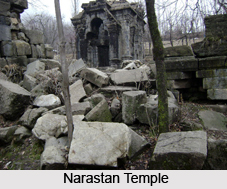 This stone temple is distinguished for its architectural works; it is dissimilar from all the other temples in the Kashmir Valley. Dating back to more than 1400 years, the temple is believed to have been dedicated to Lord Narayana (also known as Lord Vishnu, He is a major God in Hinduism, the 2nd member of the Holy Trinity). The temple faces east and now houses a Shivling, (the symbolic phallus representation of Lord Shiva) that must have been put up at a later date. The interior compound measures about 8.6 feet square. An interesting feature of the Narastan Temple is, it has no ceiling. The courtyard measures 70 feet square. From the outer wall, there is a small side entrance near the southwestern side. This circular shaped temple is wholly constructed with stones in Gandhara style of architecture.
This stone temple is distinguished for its architectural works; it is dissimilar from all the other temples in the Kashmir Valley. Dating back to more than 1400 years, the temple is believed to have been dedicated to Lord Narayana (also known as Lord Vishnu, He is a major God in Hinduism, the 2nd member of the Holy Trinity). The temple faces east and now houses a Shivling, (the symbolic phallus representation of Lord Shiva) that must have been put up at a later date. The interior compound measures about 8.6 feet square. An interesting feature of the Narastan Temple is, it has no ceiling. The courtyard measures 70 feet square. From the outer wall, there is a small side entrance near the southwestern side. This circular shaped temple is wholly constructed with stones in Gandhara style of architecture.
The temple is on a single base consisting of only four courses of stones. At the top of the pediment, there is a figure that resembles a Garuda, the king of birds, sacred vehicle to Lord Vishnu, who is half man and half eagle with the power to acquire any shape. The main draw of the temple is the trefoil arches on the peripheral of the shrine walls. Another remarkable feature is the absence of any circumambulatory path on top of the base. From the courtyard, a flight of four steps leads to the shrine of Narastan. There is a stream of water that gushes down near the front of the temple. There is another shrine located in the northern part of the chamber, which has a sloping roof and ceiling similar to that of the Pandrethan Temple. The temple can be approached on the Avantipur-Tral Road by reaching Arpal. Form Arpal village Narastan is only 6 miles away.





















